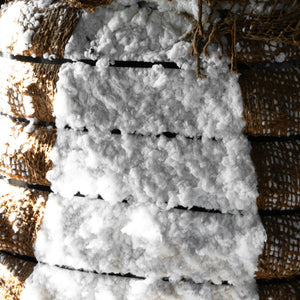Article: Build Your Due Diligence Framework: The Backbone of Responsible Fashion Supply Chains
Build Your Due Diligence Framework: The Backbone of Responsible Fashion Supply Chains
TL;DR: Effective due diligence audits your systems, not just suppliers. The strongest frameworks map purchasing, subcontracting, and recruitment pathways, link risk to live operational data, and replace annual checks with continuous monitoring.
Ask system-wide questions: can you detect routing changes, approve labor channels, and verify evidence at the source? Collect data that reveals how production actually happens: workforce-to-output ratios, subcontracting permissions, recruitment costs, capacity strain, and order routing anomalies.
Success is measured by harm prevented, not reports filed. Responsible sourcing is a core business operating model, not just a compliance task.
If you're ready to ensure responsible sourcing for your fashion brand, it's time to build a due diligence framework. Such a framework must connect commercial, sourcing, compliance, IT, HR, and sustainability decisions. It requires evidence, governance, and continuous updating and needs to align with global frameworks for systemic risk management.
The European Commission has already provided for this with the Corporate Sustainability Due Diligence Directive, which entered into force in 2024. This legislation complements the OECD's Due Diligence Guidance for Responsible Business Conduct, issued in 2018.
Effective due diligence audits the system itself — asking whether risks can be detected early, whether critical data is captured across subcontracting and labor channels, and whether decisions are based on verified indicators rather than supplier declarations.
The Power of a Strong Due Diligence Framework in Fashion
A robust due diligence framework provides for early risk detection and faster containment in crisis situations. It protects supplier relationships, delivery continuity, and sourcing reliability. For example, Principle 2 of the Common Framework for Responsible Purchasing Practices (CFRPP) notes:
"The purchasing company and their suppliers respect each other as equal business partners; engage in respectful sourcing dialogue; and pursue win-win situations, with a shared responsibility to improve working conditions."
This type of agreement protects both your brand and your suppliers, building longevity in relationships. Your framework must also create internal clarity on roles, data ownership, and escalation paths, so you can predict instead of react. This is essential for a responsible supply chain, clarifying definitions, ownership, and data standards. Clear frameworks align business goals with supplier, worker, and environmental outcomes.
Rethinking Risk in The Fashion Business
Risk management in fashion goes far beyond Tier 1 supplier checks. It includes monitoring your entire system, including purchasing, recruitment channels, subcontracting behaviors, and data blind spots. Modern frameworks focus on how production happens, not only who is contracted, reflecting an OECD-aligned approach to responsible sourcing. This allows you to shift from crisis response to early risk detection.
Instead of annual snapshots, have your teams track real-time indicators to anticipate labor spikes, capacity strain, or subcontracting changes. As Carbonfact highlights, effective due diligence is about risk prevention, not disclosure alone.
Understanding the Different Types Of Risks Hidden in Your Supply Chain
There are many kinds of risks that you need to be aware of down your supply chain. Here are a few examples and indicators for how to detect them:
|
Risk Category |
Examples |
Early Warning Indicators |
|---|---|---|
|
Human risk |
Recruitment fees, wage issues, intermediaries, overtime, document retention |
Hiring spikes, agency changes, grievance inactivity |
|
Operational risk |
Undeclared subcontracting, overflow, routing shifts, untracked sites |
Volume exceeds capacity, new locations, routing changes |
|
Business risk |
Contract instability, cost pressure, late changes, short lead times |
Frequent PO changes, shrinking lead times, chargebacks |
|
Integrity risk |
Disconnected data, missing records, unverifiable sites |
Duplicate records, mismatched addresses, missing timestamps |
How to Align Due Diligence With New Global Regulations
Most emerging regulations share the same backbone: identify, prevent, track, disclose, improve. This means due diligence must capture traceable evidence, assign clear responsibility, define escalation paths, and preserve remediation records. Companies need structured data flows, documented decision trails, and proof of how issues were resolved, not just what was reported. The strongest frameworks monitor risk patterns and treat compliance as infrastructure.

Why Legal and Financial Risks Deserve the Same Attention as Design Trends
Supply chain opacity now threatens market access, legal exposure, and investor confidence. Due diligence is the remedy. As the CFRPP highlights, purchasing practices shape labor outcomes. Legal and financial risk must be managed with the same rigor as design — supported by documented decision trails, supplier data lineage, capacity-risk thresholds, and auditable sourcing.
Inside the Due Diligence Process That Actually Works
Effective due diligence monitors entire systems, not just suppliers. This means mapping order flows, production routing, recruitment channels, and subcontracting behavior. It links purchase orders to facilities, workforce conditions, and emerging risk signals.
Key components for the fashion industry include: recruitment cost accountability, overflow site disclosure, subcontracting approvals, capacity-linked workforce data, and verified facility ownership. Instead of allowing suppliers to self-declare, true due diligence requires active verification, with continuous monitoring instead of one-off checks. This aligns with Ethical Trading Initiative (ETI) principles and OECD due diligence expectations for responsible sourcing.
How to Conduct Risk Assessments That Drive Real Impact
Not sure where to start when conducting risk assessments? Here is a list of key questions to ask:
-
Can we detect changes in production routing, sites, or subcontracting before orders begin?
-
Who controls recruitment channels and fees, and how are repayment risks tracked?
-
Do workforce numbers and skill profiles match planned order volumes and seasonality?
-
How do we verify labor, production, and facility data — and what evidence is required?
-
Which teams own risk signals, escalation steps, and corrective actions when thresholds are crossed?
Technology and Data as the New Style of Risk Management
Risk detection has shifted from static documents to real-time data relationships. Modern systems identify subcontracting changes, workforce surges, and routing anomalies before they escalate. Automated flags reveal unverified sites, intermediary involvement, and capacity shifts, linking risk signals directly to purchase order routing and labor composition. According to Sheng Lu’s research, verification must go beyond certifications toward deeper supply chain data validation. Modern transparency is permissioned, with specific access for sourcing, compliance, IT, suppliers, and auditors to preserve integrity while strengthening shared oversight.
Here are some recommendations on how to use technology as your ally in risk management:
-
Connect core systems (PLM, ERP, procurement, logistics) to create a unified purchase trail
-
Standardize supplier IDs to prevent duplication and facilitate tracking
-
Implement anomaly detection rules, such as order mismatch, facility changes, or deviated shipments
-
Require connected evidence, including geotagged records, timestamped documents, and source-linked data
-
Monitor labor indicators, such as workforce-to-output ratios and hiring spikes
-
Create role-based access so that sourcing, compliance, IT, suppliers, and auditors view only what is needed
-
Preserve immutable audit trails for all supplier, facility, order, and workforce data edits to maintain evidence integrity.
Working Hand in Hand With Suppliers and Stakeholders
Effective due diligence is constructed with suppliers, not imposed on them. Trust improves data accuracy and early risk detection. Shared frameworks outperform one-sided compliance because you set definitions collaboratively regarding subcontracting, recruitment costs, capacity limits, evidence, and risk thresholds. Strong partnerships decide when to update, which evidence is required, and remediation protocols.
Best practice means verifying recruitment channels and costs, approving overflow sites, and tracking corrective actions with proof instead of settling for self-reporting. The ETI emphasizes collaboration and ongoing engagement as foundations of a responsible supply chain practice.

The Human Side of Due Diligence
The strongest due diligence looks beyond the numbers and takes into account what people actually experience. It tracks worker agency, recruitment fairness, mobility, grievance access, and whether safeguards work in practice. Human and environmental signals are leading indicators of operational integrity — you can often identify stress in workforce patterns, resource use, or recruitment structures before it appears in audits. Integrating these indicators into decision-making protects people and reinforces supply chain resilience. For effective due diligence, continuous engagement and assessing impact on workers are key.
When you embed responsibility into your supply chain, you'll experience fewer disruptions, faster remediation, and stronger supplier relationships. This improves investor confidence and regulatory resilience for your brand.
The Future of Your Due Diligence Framework
The future of due diligence is continuous risk assessment. Static snapshots can’t track shifting production flows, labor patterns, or subcontracting pressure. Resilient frameworks monitor signals year-round, detect issues earlier, and verify interventions with evidence.
Emerging regulation such as the CSDDD is a clear reminder that human rights and environmental risks must be integrated into core sourcing and purchasing decisions. To measure the success of your framework, assess whether you prevent harm, avoid bottlenecks, and resolve risks before they impact people or production. The strongest systems prioritize prevention, responsiveness, and measurable improvement over retrospective documentation.
How to Review and Improve Your Framework Each Year
Once you've built your framework, it's important to conduct a yearly review. You'll need to test performance, not paperwork. Key questions to ask include:
-
Are risks detected earlier?
-
Are data points verified at source?
-
Are escalation rates falling?
-
And are sourcing choices informed by risk signals, not solely cost or lead time?
As the ETI emphasizes, due diligence systems must improve continuously, not stagnate at compliance.
Why Responsible Business is The Only Trend That Never Ends
Regulations, markets, and sourcing maps will continue to shift, but the fundamentals of responsible business do not change. The most durable competitive advantage is a supply chain designed to protect people, uphold standards, and maintain continuity under change. The strongest due diligence frameworks audit internal systems as rigorously as they assess external suppliers. If your framework embeds resilience, visibility, and accountability into daily operations, you'll be able to move faster, absorb disruption better, and make stronger sourcing choices over time.
In Summary
Modern due diligence goes beyond supplier audits to evaluate the systems that influence labor conditions and sourcing risk. The right framework connects purchasing, recruitment, subcontracting, and production data to identify problems before they escalate. You should ask system-level questions, verify evidence at the source, and track indicators like capacity strain, labor channels, routing changes, and workforce alignment to orders. Continuous monitoring replaces one-off audits, and shared frameworks with suppliers outweigh unilateral compliance checks. Success isn’t measured by documentation, but by preventing harm, strengthening partnerships, early risk detection, and resilient operations. Responsible business should be the core infrastructure of your fashion brand.
Q&A
What is an example of due diligence?
Verifying production sites, recruitment channels, subcontracting approvals, and workforce capacity against orders using real evidence, not supplier statements, then tracking issues until resolved.
What is due diligence in retail?
A process to manage sourcing risk by approving suppliers, production sites, labor channels, routing changes, and sourcing claims with traceable data and ongoing monitoring.
What is a red flag during due diligence?
Red flags include unapproved subcontracting, sudden site or routing changes, hiring spikes, orders exceeding capacity, third-party recruiters, or missing, inconsistent, or self-reported data.




